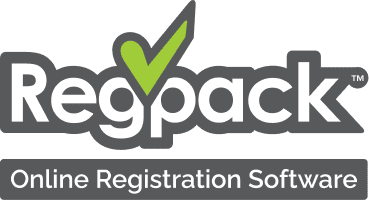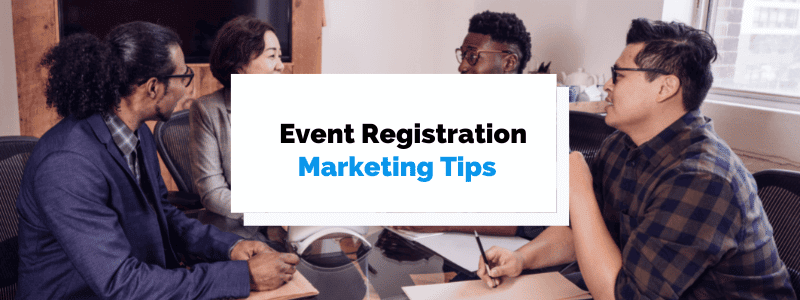So much work goes into planning an unforgettable event. Because of all this effort, it would be a shame if fewer people showed up than you expected.
That’s not just because it would be sad to look out at empty sections of seats, but also because it would imply a small return on all those hours you put into planning.
That’s why it’s so crucial to get your event marketing right.
In this article, we’ll give you six effective methods for driving event registrations and attendance, from email and social media marketing to other promotion tactics like ticket discounting and giveaways.
- Build an Eye-Catching Event Page
- Offer Early Bird Discounts
- Use Social Media to Your Advantage
- Offer Different Ticket Types
- Host a Giveaway
- Take Advantage of Email Marketing
- Conclusion
Build an Eye-Catching Event Page
One of the best ways to increase event registrations is to create an event page that is eye-catching and on-brand while still serving its primary function of providing customers with the information they need to decide if this event is a good fit for their interests and needs.
Your event page should display the following logistical information:
| Event Date & Times |
| Event Schedule |
| Location of the Event |
| Venue & Event Description |
| Frequently Asked Questions |
| Speaker Details |
It should also include information that speaks more to the heart of the attendee, namely, the major benefits they will receive from attending the event.
More than date, time, and event description, it is the benefits that will motivate people to register.
A benefit should highlight how the person’s life will change for the better, what they will come away with, what they will learn, or which desires they will fulfill by attending your event.
For example, HubSpot does a great job here of listing what attendees will learn from attending the CRM training event:
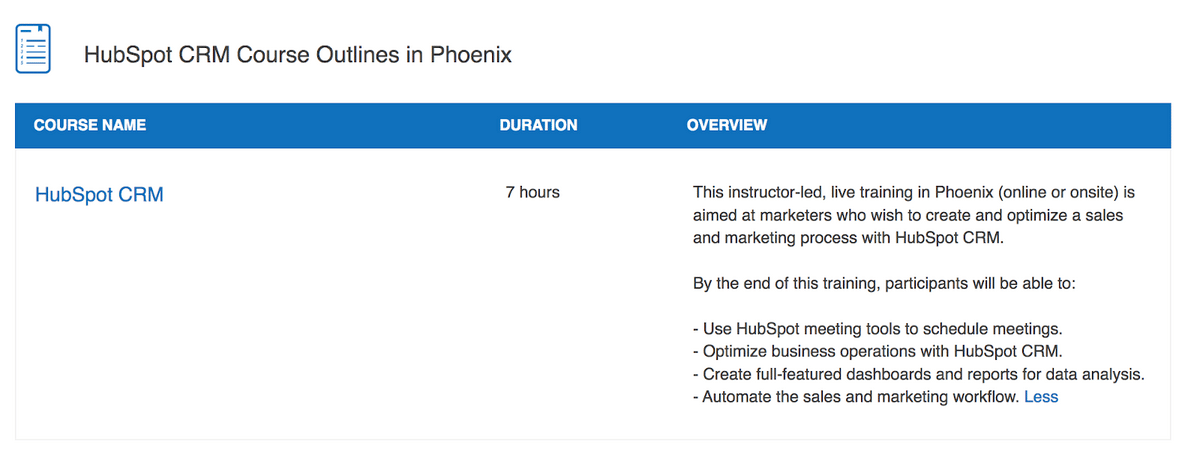
Source: NobleProg
In the Overview column, everything after “By the end of this training, participants will be able to:” are the event benefits, which would certainly entice people who are considering coming because they want to become proficient in the software to advance their careers.
Apartmentalize, an event for professionals in the property management industry, also does an excellent job at highlighting the benefits of attending:

Source: Apartmentalize
By creating a Top 4 Reasons to Attend section on the event page, they make it extremely easy to find the benefits.
They also allow page visitors to explore each benefit more in-depth by providing a brief description and the option to go onto another page to learn more.

Source: Apartmentalize
This allows visitors to spend time researching what matters most to them.
If someone was mostly interested in the networking aspect, they could read more about all the opportunities they’ll have to meet potential clients.
On top of listing basic information and benefits, your event page should also use your brand’s color scheme, fonts, voice, logo, and other brand specifications.
This gives customers a consistent experience with your company and makes you more memorable.
Lastly, it’s important to make it easy for your visitors to find the information they need, or else they’ll get frustrated and bounce.
That means spending time creating a user-friendly page layout rich with white space, headings, buttons, and other elements that facilitate skimming page navigation.
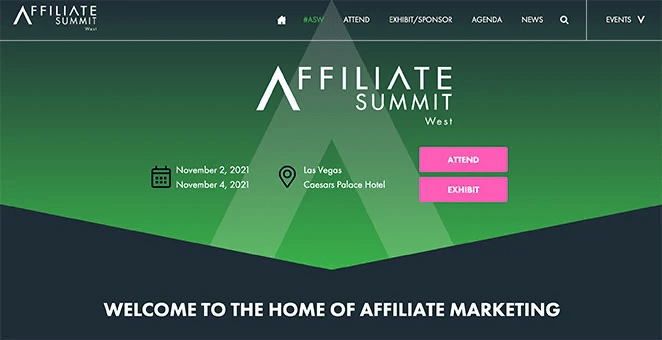
Source: Affiliate summit west
The above page is organized, on-brand, and easy to navigate, as it provides visitors with a menu at the top of the page that they can use to find information that pertains to their needs, like event agenda or sponsor details.
Offer Early Bird Discounts
Offering discounts to people who register early is an excellent tactic for increasing your number of event registrants. This type of promotion is known as an early bird discount.
Doing this not only secures you a wide swathe of attendees who might’ve otherwise not attended at the higher price point, but it also creates some early buzz around your event.
Either in conversation or via social media, those people who bought the early bird tickets are sure to tell their friends and colleagues about the event way before it is set to occur.
You’ve in essence created salespeople for your event. And the hundreds of people they tell about the event have plenty of time to make a decision about coming.
To create an effective early bird discount, you need to set a firm deadline for eligible sign-ups.
As a rule of thumb, the low price should expire somewhere between 10-15 weeks before the event takes place.
To get this message across and increase a sense of urgency, it can help to have a countdown timer on your event page:

Source: Leadpages
Early-bird discounts should also include a limited number of discounted tickets. As you can see in the image above, this company has made it clear that spaces are limited.
This creates scarcity, which again creates a sense of urgency in the buyer.
Setting a limit on discounted tickets also helps you create a more systematic pricing strategy, since you know the maximum number of tickets that can be sold at this low price.
Best of all, when you offer early bird specials, the customers who buy them will feel more loyal to your brand because you’ve rewarded them for their support.
Use Social Media to Your Advantage
Spreading the word about your event over social media channels used by your target audience is another great way to increase event registration.
By posting regularly on Twitter, Instagram, LinkedIn, and Facebook, you can periodically inform your followers about the event.
Share customer stories from last year’s event, hype videos, speaker introductions, ticket sale promotions, competitions, and anything else that will create buzz and registrations for your event.
If the posts are engaging, users will be more likely to comment on or share them, giving the post an opportunity to appear on the news feeds of numerous people beyond your current followers.
You can also expand your marketing reach by paying for social media ads, and these can be targeted to reach people who perfectly fit your target audience.
Another effective way to reach more social media users is to collaborate with an influencer, someone with a following consisting of people who would likely be interested in attending your event.
For a fee, the influencer will promote your event to this audience in their posts.
Because of its effectiveness, influencer marketing has been growing in popularity for years:

Source: Tinuiti
By working with an influencer, you are essentially piggybacking on the trust they have already built with their audience.
So these conversions from stranger to registrant happen at a higher rate than if these people were to hear about your event from your brand instead of from their trusted influencer.
The key, of course, is to find an influencer in your industry who has a large base of people who fit your ideal customer profile.
For example, if you were selling tickets to a conference on saving the bees, you could collaborate with a wildlife conservation influencer who has an audience full of environmentalists, scholars and other professionals in the field.
Using influencers and other social media marketing techniques to advertise your event can dramatically increase the number of people who attend your events.
Offer Different Ticket Types
Offering multiple types of tickets increases the likelihood that each potential attendee finds a ticket that suits their specific needs and preferences.
The below expo offers three main types:

Source: Bizzabo
For example, not everyone will want to stay at a 2-day event for the entire time.
Some might rather just come for one day, and if they don’t see that option on your registration form, along with the reflected lower price, they’ll probably opt out altogether.
Aside from the aforementioned early-bird tickets, here are some other common ones to offer:
| VIP passes | VIP passes are for your superfans and experience-seekers, those who will pay extra for things like transportation to and from the airport or a special dinner event. |
| Group registrations | This ticket type enables one person to register an entire group of other people, from students to colleagues. |
| General attendee | This is the ticket type that the majority of your audience will buy. It should also be the middle price. |
| Limited package | This is a ticket that’s cheaper than the general attendee ticket. It therefore offers limited access to the event and is a good option for those who are on the fence about coming. |
| One- or multi-day passes | For multi-day events, give your registrants the option to stay for one, two, all the days, or anything in between. |
When you offer different ticket types, you are giving each attendee a more curated experience. And this will lead to happier attendees who come back next year.
Finally, you’re less likely to have customers who feel that they paid too much because they didn’t take advantage of all of the ticket’s offerings.
Host a Giveaway
A social media giveaway is when you incentivize social media users to engage with one of your posts by offering a chance to win special prizes like a free ticket or access to the VIP lounge for the afterparty.
This engagement usually takes the form of account follows, comments, likes, shares, tags, or some combination of the above, as done below:

Source: eventbrite
Hosting giveaways is a fantastic way to win event registrations. This method not only delights your followers, but also creates social media buzz around your event.
Because these types of incentivizing posts are designed to receive a lot of engagement, it’s likely that they will show up on more peoples’ newsfeeds than a regular post.
That’s especially the case if you tell your followers to tag their friends who might be interested in the event or have your followers share the event on these friends’ social pages.
According to referral marketing research, 49% of U.S. consumers say friends and family are their top sources of brand awareness.
And a staggering 74% of consumers report being influenced by word-of-mouth recommendations when deciding to make a purchase.
Here’s an example of a company encouraging its followers to tag friends for a chance at a $100 gift card at their Spring Savings Event:

Source: SocialBee
When someone gets tagged on a giveaway post by another friend, they’re more likely to register for the event, or at least enter in a chance to win the competition, than if they were to come across the post on their own wanderings through social media.
Take Advantage of Email Marketing
Email marketing is an effective, personal, and low-cost method for marketing your event.
You can use your email list to reach out to people who might be a good fit for the event, whether those are previous customers and attendees or entirely new contacts.
With email automation software, like MailChimp, which connects to your CRM or mailing list, it’s extremely easy to send out mass emails that are still personalized to each individual, automatically including details like the recipient’s name.
There are some best practices to follow for writing your event marketing emails.
First off, you should use a brief subject line that grabs the recipient’s attention by speaking to their interests.
A great subject line could therefore be a benefit of attending your event: “CEOs, master the art of negotiation at {Event Name}” would be an effective subject line for someone hosting an event for members of the C-suite interested in improving their negotiating skills.
Once the recipient opens the email, they should immediately receive context.
According to copy.io’s guide to writing event email marketing copy, there’s a framework for the ideal body of an event promotion email:

Source: copy.ai
The best call-to-action (CTA) for your event marketing email will usually be a link to your event page, where potential attendees can do more research on the event and buy tickets.
Here’s an example of an event marketing email from Union Jack that works wonderfully:
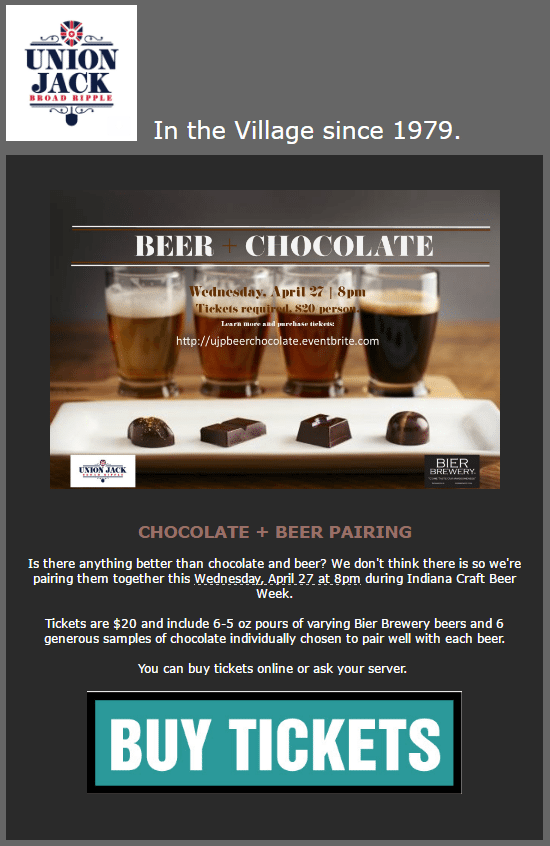
Source: Delivra
And here’s another email for a conference about no-code technology. This one highlights the limited time to get low-priced tickets as the main reason to register ASAP.

Source: mailerlite.com
But, regardless of how well-written your email is, one email usually isn’t enough to win over an attendee.
Typically, you should send each ideal customer 5-7 marketing emails before considering them a loss.
You can devote each follow-up email in the sequence to sharing information specific to one aspect of your event.
Here’s a potential email marketing cadence:
- Introduce the event.
- Highlight a top benefit.
- Share a promotional video in a hype email.
- Give a sneak peek of the speakers.
- List the agenda.
- Make a final attempt at winning their attendance.
This way, over the course of a few weeks, you’re slowly dripping event information that might sway the potential attendee to register.
Ideally, the more emails they open from you, the more familiar they become with your brand and the more convinced they become about attending the event.
Conclusion
You want all your hard work in event planning to pay off, and in order to do so, you need to spend some time marketing your event so that a boatload of people register and show up.
Some of the best event marketing techniques include creating an engaging event page, running social media giveaways, leveraging email marketing, and employing ticketing strategies like early bird specials and multiple ticket types.
For more information about how to increase registrations for your next big event, check out our article on eight event registration tips.
